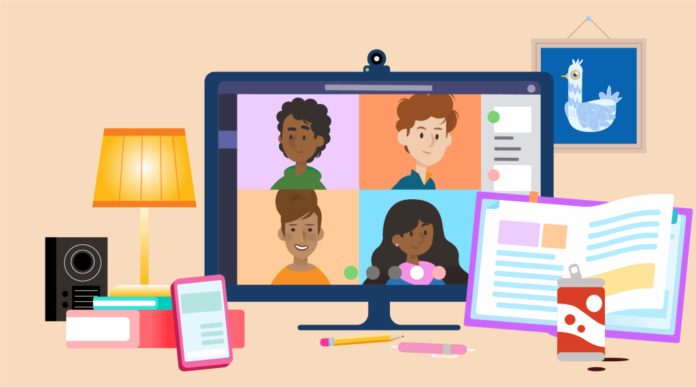When something is described to be “chaotic, confusing, scattered, incomplete, stressful, overwhelming, horrible, and like hell,” that something is clearly in need of improvement. These are just a few descriptors that have been used by parents and teachers to describe their elementary student’s virtual learning environment as a result of the COVID-19 pandemic. The abrupt change from in-person to remote education in an effort to reduce the spread of COVID-19 has thrown millions of families into strenuous and demanding situations. The following Op-ed outlines the vast array of issues impacting school communities around the world. Throughout my research, I realized the main problem for young students is that home environments are widely disparate and highly unequal. For some, the home environment can be a productive, conducive place to learn. Others lack such an atmosphere, putting economically and developmentally challenged students at a disadvantage.
Who’s at Stake?
The three main stakeholders who are most directly affected by the issues in this design problematic are the students in grades K-5, their parents, and their teachers. While remote learning is arguably more beneficial towards older, more independent students, this type of learning doesn’t correctly suite children who require structure and consistency to understand cognitive basics and stay on track. Therefore, students in grades K-5 will be the targeted audience in this research project.
Gathering information from the parent perspective helps to get a deeper insight into the daily experiences that students are going through, but these are limited to parents who are opinionated and more engaged when comes to their child’s education. Just focusing on the parents skews the design world in the direction of more privileged families. In contrast, getting information from teachers not only shows their own perspectives but gives insight into other types of family situations (i.e. parents who are not as involved or don’t have time to check Facebook to take a survey). One teacher highlights this perspective when saying, “Some parent pushback with online learning is that they feel that it is not their job to help or make sure their child is completing the work. Some parents feel that it is not important and their child will learn when we go back to school.” Additionally, teachers provide insight into parents who care so much that they end up doing the work for their children. “Many of the students are overly stressed, because they have either too much (sometimes too harsh) supervision, or too little supervision and guidance,” another teacher described. It’s important to take all types of home environments into consideration to fully understand this design problematic.
When framing this design world, it’s also important to note that virtual learning during COVID-19 should not be compared to traditional online learning. The type of learning that has resulted from COVID-19 is referred to as Emergency Remote Teaching (ERT), which is defined as “a temporary shift of instructional delivery to an alternate delivery mode due to crisis circumstances” (Hodges et al., 2020). ERT is distinct from ordinary online teaching and learning, in which virtual experiences and online instruction have been planned from the beginning. Teachers and students in the two types of learning have drastically different experiences, which is why this problematic is not a critique of online learning as it is traditionally used. The problems discussed in this paper specifically revolve around virtual learning as a direct result of the COVID-19 pandemic.
Personal Connection
What sparked my interest in the topic of online learning was my experience working for a family in the suburban area of Upper Arlington, Ohio with the virtual education of their second-grade son, Julian. He is my first and largest influence on the topic, serving as a “case study” of sorts. While I’ve made an effort not to fixate my understanding solely on my Julian’s situation, I found through research that a lot of Julian’s challenges with online learning are shared by other students with different learning environments. His learning space has changed drastically throughout my time assisting with his schooling, but certain problems still limit him from achieving similar success as in-person education.
From my limited perspective of a brief four weeks of research, I have narrowed the vast array of problems associated with remote learning into three categories; Learning-related problems, social-emotional problems, and problems faced specifically by the economically and developmentally challenged.
Learning-Related Problems
The learning-related problems with remote education involve everything that prevents students from receiving the same quality of education (in a cognitive development sense) as they normally would while physically in school. According to teachers’ survey responses, three of the biggest issues learning-related issues were unfinished work, home distractions, and staying focused in long video calls. One parent expresses frustration saying, “He hates it. Trying to keep him interested is a huge challenge when he has to sit in front of a computer all day with 90 minute classes.” This seems to be the case for many other children, one parent saying, “They thrive on routine and structure. They need interaction with their peers and other adults in positions of authority.” Because of this, many parents worry about set-backs in their child’s development. One survey parent explained, “[My son] missed learning many foundational skills for literacy because of the abrupt switch and continuation this school year of online learning.” Another parent said, “I don’t think he learned anything in the Spring and he’s covering less material now than he would in a normal year.” At-home environments are proving to be insufficient in fostering conducive learning for many children without the regulation and immediate assistance that teachers can provide in-person.
In virtual environments, teachers have difficulty encouraging student participation, keeping up with student progress, dealing with technological difficulties. The largest problem for teachers, according to the survey, is difficulty adapting teaching methods to the virtual setting. In an interview with a second-grade teacher in a suburban school in Sylvania Ohio, she expresses frustration saying, “I’ve been through the wringer with all this change. It’s unbelievable the amount of extra work I have put into reworking my lesson plans and trying to understand technology.” With approximately 41.7% of those surveyed are in some type of hybrid setting (class time is partially in-person and partially online), teachers are required to plan twice as many lesson plans. “My stress level has doubled,” a second-grade teacher stated in an interview when asked about the hybrid model. Learning new and age-appropriate online platforms has been a challenge for many teachers who aren’t as tech savvy. “It’s hard for an old lady like me, I don’t understand tech like you kids.”
Overall, a reoccurring theme of Emergency Remote Teaching (ERT) is disorganization.One surveyed parent said, “It’s been inconsistent and lacking structure. Parents and teachers are doing twice the workload with half the results.” Children have difficulty learning when their homes are not suitable for focus and discipline while teachers have difficulty teaching when they don’t have in-person interaction with their students.
The Social-Emotional Problems
The social-emotional issues associated with ERT present a whole different set of challenges for students, teacher, and parents alike. Lack of social interaction with peers is the number one overall issue for students, as determined by the teachers who participated in my survey. One parent validated this by saying, “My son needs social interaction to learn and the online lessons don’t provide that.” Additionally, stress and anxiety levels have been at an all-time high.
I’m simply not sure how much longer we can to do this before I honestly break. The days they are in-school are amazing — the kids are happy and I can get work done and feel like the adult professional I need to be. But the at-home school days are a ball of stress, frustration and worry — am I doing enough for my kids to help them? Are they falling behind? Are they emotionally and socially stable? Will this have lasting, detrimental effects on their school progression? There are so many unknowns, and it’s very overwhelming.
quote from a parent SURVEY capturing high STRESS LEVELS
Teachers are also struggling with stress and low mental health. A teacher from Title 1 school in Columbus, North Lindon, said in an interview, “In regard to staff morale, I’ve never seen it as bad as its been. Some are trying to be furloughed and there’s all very negative energy.” Another from the survey explained how, “There’s little to zero downtime. I feel like I’m a personal assistant. I also have a middle schooler and both my children are on either an IEP or a 504 plan. It’s hard to find a balance. My brain never rests. It’s constantly trying to keep them on task. My anxiety levels and sleeplessness have increased. I had to begin taking anxiety meds.”
Challenges For Low Income Families
The third category of remote education related problems, and arguably most crucial to find a solution to, involves all those experienced specifically by economically and developmentally challenged students. These include students in low income families and special needs students.
The previously states exhaustive list of learning and social-emotional issues created by ERT are ones that are experienced by families regardless of socio-economic status. But an additional issue arises when lower income families don’t have the means or resources to find their own solutions, while other families can. Parents who make a higher income are able to afford tutors to solve the problem of unfinished work, or better computers or WIFI connection to solve the problem of technical barriers. What do students do who aren’t privileged with such opportunities? Students who don’t even have access to the appropriate resources are the most vulnerable. Children born into privileged families with opportunities to purchase anything they don’t already have will suffer much less than those who don’t have the means to do so.
In an interview with a teacher from Title One school in Columbus, Ohio, in which 90% of their students are in poverty, the real problem isn’t so much the quality of learning, it’s really a lack of basic human needs. She explained, “For our demographic, one of the major issues is that they don’t get meals from school or a break from their abusive households. Yesterday I was in a class with three children crying because they were so hungry. It almost makes us hate our jobs, knowing these children are hungry and in abusive homes. School is normally an escape for them and they can’t even get that anymore.” Problems like these require much more research to help find solutions, but none-the-less vital to understanding the scope of remote learning.
Special needs children (Dyslexia, autism, individualized education programs) also fall under a similar category of those experiencing additional challenges during ERT. One surveyed parent said “We’ve struggled because my son has ASD and he was not able to receive his therapies in person which is really how they should be conducted to support his needs.”
In Conclusion
Remote education exacerbates the already alarming inequality existing among American school children, both in terms of learning spaces and available resources. It’s nothing less than a wicked problem that has many moving parts and influences. Many parents have provided validation in regard to the importance of adapting education for students in a post-pandemic world.One parent showed gratitude saying, “It’sgood that people realize that there has been a major shift. This is a major life change for everyone and needs to be studied so we can learn and improve.” One thing is for certain, virtual education most likely won’t last forever, but its impact on educational development will affect children around the world for years to come.




